
Page 8: of Maritime Reporter Magazine (November 2012)
Workboat Annual
Read this page in Pdf, Flash or Html5 edition of November 2012 Maritime Reporter Magazine
Gregory R. Trauthwein, Editor & Associate Publisher [email protected] EDITORIALAt the age of 46 I have just experienced my first real fuel shortage; complete with hours long waits in mile-long gas station lines; complete with police presence at nearly every pump; complete with modification of my driving habits in and around New York to conserve fuel. (For the record, I am not counting the fuel shortages of the mid 70?s ? I was alive and aware, but I was 8, and did not re- ally care!)Mind you, I?m not complaining in the least, as I consider myself, my family and that of my immediate colleagues here at Maritime Reporter & Engineering News quite lucky. Unlike tens of thousands of metro-area New Yorkers who literally lost everything in the devastation and aftermath of Hurricane Sandy, we personally rode out the storm relatively well, with the blip of a power outage and requisite closure of our lower Manhattan office for one week. In addition, on numerous occasions I have lived vicariously through colleagues in our Florida office, and friends and business partners throughout the Gulf of Mexico area who more regularly have their lives and businesses dis- rupted by Mother Nature.However, it did provide much time of reflection, particularly on the issues of power and fuel, as there?s not much else to do while waiting in line for hours to get some. This being our Annual Workboat edition ? starting out with the cover which depicts Crowley?s incredible new Ocean Wave and Joe Keefe?s follow up report on builder Bollinger in the wake of his visit there last month for the christening (starting on page 58) ? the edition is packed with sto- ries on the boats, the owners, the builders and the technologies that make the sector vibrant. But as is the case with nearly every single edition of MR that I?ve had a hand in producing over the last 20+ years, there is another re- curring, underlying theme emerging within: Fuel. Now I understand that in November 2012 reporting that fuel ? quality, price, supply and the host of technical and legal offshoots that ensue ? is hardly transcendent. Chatter on the topic is neither new or news. However, it is de- veloping as THEtopic that will help shape and define this market, from the deep draft to the shallow draft, com- mercial to naval, for a the coming generation. Pick your topic: Slow Steaming; LNG as fuel; Emission monitoring and control; Distillates ? the list is growing longer every day, and each topic has its own extensive list of financial, technical and legal sub-sectors. Classification society DNV delivered its own take on the topic with its ?Shipping 2020? report unveiled earlier this summer, a report that outlined the challenges facing vessel owners in the coming decade in regards to emis- sion reduction and energy saving technologies. The central theme? You guessed, it: Fuel. By 2020 DNV estimates that 30% of newbuilds will be delivered with gas engines. More enlightening, though, is its projections on the use of distillates, as Tor E. Svensen, President, DNV, explained: ?The Shipping 2020 report predicts that demand for marine distillates will be 200-250 million tons by 2020, ver- sus today?s demand of about 30 million tons per year. To put this in perspective, 200 to 250 million tons per year equals the entire distillate consumption of the United States in 2010: This is a huge increase.? Coming full circle to my recent hours wasted waiting in line for my rationed $40 worth of gas, there are enough technical and legislative nuances surrounding marine fuel to fill dozens of volumes of this 132-page size edition of Maritime Reporter & Engineering News. But the recurring, gnawing issue that has everyone on edge is the po-tentialshortage of fuel to meet new environmental limits from the IMO and the U.S. EPA. Last month the International Chamber of Shipping (ICS), whose members represent more than 80% of the world merchant fleet, expressed dismay at a decision by the IMO to reject its call to accelerate a critical study into the global availability of low sulfur fuel for ships. ICS contends that fuel is by far the largest operational cost for ship owners and has already increased in price by about 400% since 2000. ICS went on to say that the current 50% price differential between low sulfur distillate and the residual fuel oil that is currently in use is predicted to increase even more if the new demand that will be created by the requirements is not matched by increased supply. In short, there is a palpable fear, many years out, that there will be legislatively induced ?gas lines? for the com- mercial maritime market ? or that lack of supply will conspire to make legislatively mandated fuel prohibitively expensive ? a theorized event that if turned to reality, would serve to bring global commerce to a screeching halt, and make the just past economic meltdown look like a ripple. Fuel for ThoughtMR#11 (1-9):MR Template 11/8/2012 9:13 AM Page 8

 7
7

 9
9
